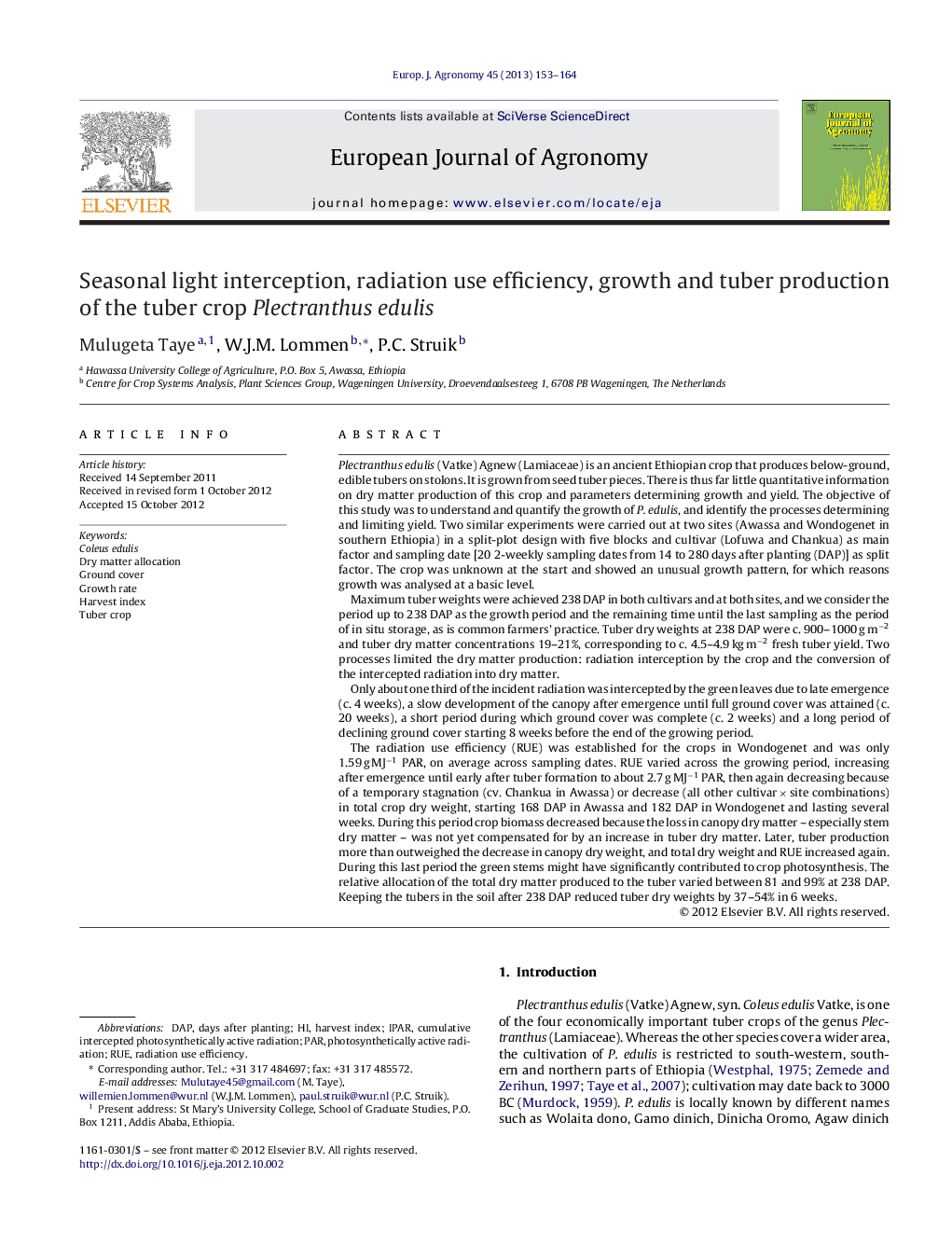| کد مقاله | کد نشریه | سال انتشار | مقاله انگلیسی | نسخه تمام متن |
|---|---|---|---|---|
| 4509067 | 1624481 | 2013 | 12 صفحه PDF | دانلود رایگان |

Plectranthus edulis (Vatke) Agnew (Lamiaceae) is an ancient Ethiopian crop that produces below-ground, edible tubers on stolons. It is grown from seed tuber pieces. There is thus far little quantitative information on dry matter production of this crop and parameters determining growth and yield. The objective of this study was to understand and quantify the growth of P. edulis, and identify the processes determining and limiting yield. Two similar experiments were carried out at two sites (Awassa and Wondogenet in southern Ethiopia) in a split-plot design with five blocks and cultivar (Lofuwa and Chankua) as main factor and sampling date [20 2-weekly sampling dates from 14 to 280 days after planting (DAP)] as split factor. The crop was unknown at the start and showed an unusual growth pattern, for which reasons growth was analysed at a basic level.Maximum tuber weights were achieved 238 DAP in both cultivars and at both sites, and we consider the period up to 238 DAP as the growth period and the remaining time until the last sampling as the period of in situ storage, as is common farmers’ practice. Tuber dry weights at 238 DAP were c. 900–1000 g m−2 and tuber dry matter concentrations 19–21%, corresponding to c. 4.5–4.9 kg m−2 fresh tuber yield. Two processes limited the dry matter production: radiation interception by the crop and the conversion of the intercepted radiation into dry matter.Only about one third of the incident radiation was intercepted by the green leaves due to late emergence (c. 4 weeks), a slow development of the canopy after emergence until full ground cover was attained (c. 20 weeks), a short period during which ground cover was complete (c. 2 weeks) and a long period of declining ground cover starting 8 weeks before the end of the growing period.The radiation use efficiency (RUE) was established for the crops in Wondogenet and was only 1.59 g MJ−1 PAR, on average across sampling dates. RUE varied across the growing period, increasing after emergence until early after tuber formation to about 2.7 g MJ−1 PAR, then again decreasing because of a temporary stagnation (cv. Chankua in Awassa) or decrease (all other cultivar × site combinations) in total crop dry weight, starting 168 DAP in Awassa and 182 DAP in Wondogenet and lasting several weeks. During this period crop biomass decreased because the loss in canopy dry matter – especially stem dry matter – was not yet compensated for by an increase in tuber dry matter. Later, tuber production more than outweighed the decrease in canopy dry weight, and total dry weight and RUE increased again. During this last period the green stems might have significantly contributed to crop photosynthesis. The relative allocation of the total dry matter produced to the tuber varied between 81 and 99% at 238 DAP. Keeping the tubers in the soil after 238 DAP reduced tuber dry weights by 37–54% in 6 weeks.
► Plectranthus edulis (Lamiaceae) is an indigenous tuber crop in Ethiopia.
► The crop showed a long growth duration and unbalanced growth pattern.
► Late achievement of full canopy cover and early canopy senescence limited IPAR.
► Low RUE during early growth and early after tuber initiation limited conversion of IPAR into dry matter.
► Fresh tuber yields obtained at 238 DAP were 4.5–4.9 kg m−2.
Journal: European Journal of Agronomy - Volume 45, February 2013, Pages 153–164